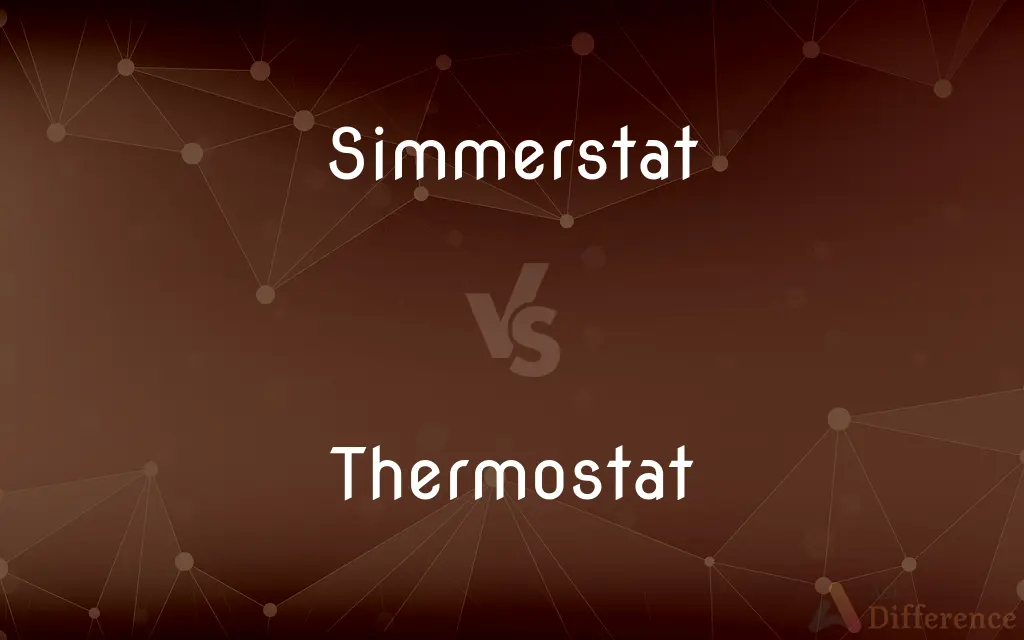Simmerstat vs. Thermostat — What's the Difference?
Edited by Tayyaba Rehman — By Fiza Rafique — Updated on October 31, 2023
Simmerstat controls the power input to maintain a desired temperature, while a thermostat cycles on and off to regulate temperature.

Difference Between Simmerstat and Thermostat
Table of Contents
ADVERTISEMENT
Key Differences
Simmerstat is a control device primarily used in electric stovetops or cooktops. It modulates the power input to maintain a desired cooking temperature over an extended period of time. On the other hand, a thermostat is a device that maintains a specific temperature by cycling a system (like a furnace or air conditioner) on and off based on the ambient temperature.
In terms of functionality, a Simmerstat offers a more continuous power regulation, ensuring a consistent temperature without frequent on-off cycles. Meanwhile, a thermostat tends to maintain temperature by initiating a full power on state until the desired temperature is reached, and then it turns the system off until the temperature drops again.
The applications of both are distinct too. Simmerstat is commonly found in cooking appliances, providing chefs with the ability to simmer food without burning. A thermostat, in contrast, is ubiquitous in heating, ventilation, and air conditioning (HVAC) systems, ensuring a comfortable environment inside homes and offices.
When talking about energy efficiency, a Simmerstat provides a more even distribution of energy, preventing power spikes. Conversely, a thermostat might lead to power surges each time the system turns on, potentially leading to more wear and tear over time.
Lastly, while both Simmerstat and thermostat are designed to control temperatures, their methods of achieving this are different. Simmerstat does so through power modulation, and a thermostat does it through cycling.
ADVERTISEMENT
Comparison Chart
Function
Modulates power to maintain temperature
Cycles system on and off to regulate temperature
Primary Use
Electric stovetops or cooktops
HVAC systems
Method
Continuous power regulation
On-off cycles
Energy Distribution
Even, prevents power spikes
Can lead to power surges during on cycles
Temperature Maintenance
Through power modulation
Through cycling
Compare with Definitions
Simmerstat
Simmerstat controls the power input for desired temperature.
I set the Simmerstat at a medium level for gentle simmering.
Thermostat
Thermostat is a device regulating ambient temperature.
I set the thermostat to 72°F for a comfortable room temperature.
Simmerstat
Simmerstat offers continuous power without frequent on-off cycles.
Thanks to the Simmerstat, the electric stove provides a steady heat.
Thermostat
Thermostat can be manual or smart, with programmable settings.
I upgraded to a smart thermostat for automated temperature schedules.
Simmerstat
Simmerstat is synonymous with energy efficiency in cooking appliances.
Using a Simmerstat helps save energy by modulating the power input.
Thermostat
Thermostat maintains temperature by cycling HVAC systems.
When it gets too cold, the thermostat activates the furnace.
Simmerstat
Simmerstat is a power modulator for cooking devices.
I adjusted the Simmerstat to maintain a consistent boiling temperature.
Thermostat
Thermostat responds to changes in the surrounding environment.
The thermostat turns the AC on when the room heats up.
Simmerstat
Simmerstat ensures even heat distribution in stovetops.
The Simmerstat helps prevent my soup from burning by distributing heat evenly.
Thermostat
Thermostat ensures energy efficiency in home environments.
Installing a smart thermostat can reduce monthly energy bills.
Simmerstat
An electrical control device that turns a heating element such as a stove, hotplate or grill on and off in a user-selectable duty cycle: for example, five of every 20 seconds.
Thermostat
A thermostat is a regulating device component which senses the temperature of a physical system and performs actions so that the system's temperature is maintained near a desired setpoint. Thermostats are used in any device or system that heats or cools to a setpoint temperature, examples include building heating, central heating, air conditioners, HVAC systems, water heaters, as well as kitchen equipment including ovens and refrigerators and medical and scientific incubators.
Thermostat
A device that automatically regulates temperature, or that activates a device when the temperature reaches a certain point.
Thermostat
A device, as in a home heating system, a refrigerator, or an air conditioner, that automatically responds to temperature changes and activates switches controlling the equipment.
Thermostat
A device that automatically responds to changes in temperature by activating a heating or cooling system to maintain the temperature at a desired setting.
Thermostat
(physics) An algorithm used to maintain a simulated system at a set temperature by absorbing or releasing heat
Thermostat
A device which automatically regulates temperature, or provides a signal used by another device to regulate temperature. The temperature-sensitive signal may be electronic, as that produced by a thermocouple. The signal may also be caused mechanically, as by the unequal expansion of different metals, liquids, or gases by heat, which can then cause the opening or closing of the damper of a stove, or the like, as the heat becomes greater or less than is desired.
Thermostat
A regulator for automatically regulating temperature by starting or stopping the supply of heat
Thermostat
Control the temperature with a thermostat
Common Curiosities
How does a thermostat differ from a Simmerstat in energy usage?
A thermostat may lead to power surges during on cycles, while a Simmerstat provides even energy distribution.
What is a Simmerstat used for?
Simmerstat is used for modulating power in electric stovetops or cooktops to maintain a desired temperature.
How does a Thermostat function?
A thermostat maintains a specific temperature by cycling a system, like a furnace or AC, on and off based on the ambient temperature.
Can a Simmerstat replace a thermostat in HVAC systems?
No, a Simmerstat is primarily designed for cooking appliances, while thermostats are for HVAC systems.
What's the advantage of a programmable thermostat?
A programmable thermostat allows for automated temperature schedules, potentially saving energy and costs.
Is a Simmerstat similar to a dimmer switch?
In principle, yes. Both modulate power, but Simmerstat is specific to cooking appliances, and a dimmer is for lights.
How does a Simmerstat ensure even cooking?
By providing continuous power regulation, a Simmerstat ensures even heat distribution on the stovetop.
How do I know if my stove uses a Simmerstat?
Check the stove's manual or specifications; if it mentions power modulation for temperature control, it likely uses a Simmerstat.
Why is it called a "Simmerstat"?
The name suggests its function: to maintain a "simmer" state or consistent temperature in cooking devices.
Can thermostats be used for applications outside HVAC?
Yes, thermostats can be used in any system requiring temperature regulation, such as water heaters or refrigerators.
Are there smart versions of Simmerstats like smart thermostats?
While smart thermostats are common, Simmerstats are typically simpler devices without "smart" capabilities.
Are Simmerstats exclusive to electric stoves?
Mostly, yes. Simmerstats are designed for electric stovetops or cooktops to modulate power.
Why might someone prefer a manual thermostat over a smart one?
Manual thermostats are simpler, more straightforward, and might be preferred for their ease of use or cost-effectiveness.
Can both Simmerstat and thermostat be used in one device?
While uncommon, it's possible for a device, especially a multi-functional one, to use both for different purposes.
Can a faulty thermostat affect my HVAC's efficiency?
Yes, a malfunctioning thermostat can cause the HVAC system to run inefficiently, increasing energy consumption.
Share Your Discovery

Previous Comparison
Aniline vs. Anilide
Next Comparison
Winge vs. WhingeAuthor Spotlight
Written by
Fiza RafiqueFiza Rafique is a skilled content writer at AskDifference.com, where she meticulously refines and enhances written pieces. Drawing from her vast editorial expertise, Fiza ensures clarity, accuracy, and precision in every article. Passionate about language, she continually seeks to elevate the quality of content for readers worldwide.
Edited by
Tayyaba RehmanTayyaba Rehman is a distinguished writer, currently serving as a primary contributor to askdifference.com. As a researcher in semantics and etymology, Tayyaba's passion for the complexity of languages and their distinctions has found a perfect home on the platform. Tayyaba delves into the intricacies of language, distinguishing between commonly confused words and phrases, thereby providing clarity for readers worldwide.














































